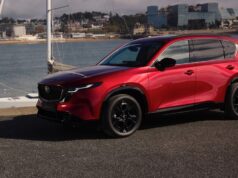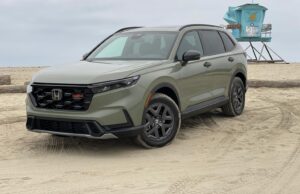
For the first time ever, an automotive brand has received top safety ratings from the NHTSA and IIHS for every vehicle in its lineup and that title goes to the Acura brand.
“No other automotive brand has accomplished what Acura has, nor can make the safety claims that Acura can,” said John Mendel, executive vice president of automobile sales. “When consumers think safety, they really should think Acura.”
Acura’s safety scores are a direct result of Acura’s “Safety Through Innovation” initiative that is based on the brand’s commitment to leadership in safety.
PRESS RELEASE:
Acura Achieves Another Historic First in Safety Testing
Entire Acura Line-up Receives Top Safety Ratings from NHTSA and IIHS for Crash Worthiness
TORRANCE, Calif., March 31, 2009 – For the first time in the history of automotive safety crash testing, an automobile nameplate has simultaneously earned top government and IIHS safety ratings for every vehicle in its line-up.
On March 25, 2009, the National Highway Traffic Safety Administration (NHTSA*), as part of its New Car Assessment Program (NCAP) testing, awarded the all-new 2009 Acura TL performance luxury sedan a 5-Star rating – its top rating – for side impact crash safety for both front and rear passenger seating positions. In earlier NHTSA testing, the 2009 TL achieved top safety ratings (a 5-Star rating for frontal crash performance for both driver and front passenger along with a 5-Star rating for Rollover resistance) meaning the 2009 TL now ranks as a top performer in all governmental safety ratings.
In November 2008 the Insurance Institute for Highway Safety (IIHS) awarded the 2009 Acura TL performance luxury sedan its top safety rating of “GOOD” for Frontal Offset Crash Test, Side Impact Crashworthiness Evaluation (SICE) and Rear Crash Evaluation. Furthermore, all Acura vehicles employ Vehicle Stability Assist™ (VSA®), an electronic stability control system that, when combined with GOOD ratings in Frontal, Side and Rear crash protection allow every 2009 Acura model to earn the IIHS’ prestigious TOP SAFETY PICK rating.
“Acura’s achievement means that no matter which Acura model buyers choose, they’re getting a high level protection for the most common types of real-world crashes,” said IIHS president Adrian Lund.
The 2009 TL’s top safety ratings, combined with the rest of the Acura line-up’s top safety ratings from NHTSA and IIHS, mark the first time in history that an automotive nameplate has achieved top honors for front, side and rear crash worthiness for all of the vehicles in its lineup.
“No other automotive brand has accomplished what Acura has, nor can make the safety claims that Acura can,” said John Mendel, executive vice president of automobile sales. “When consumers think safety, they really should think Acura.”
The NHTSA and IIHS safety ratings are a direct result of Acura’s “Safety Through Innovation” initiative that is based on the brand’s commitment to leadership in safety. The initiative’s goal is for all Acura models to provide a high level of occupant protection along with injury mitigation to pedestrians, as well as increased crash compatibility with other passenger vehicles – regardless of vehicle size or price.
For 2009, all Acura models include as standard equipment the Advanced Compatibility Engineering™ (ACE™) body structure along with a host of other standard safety equipment including Vehicle Stability Assist™ (VSA®), anti-lock braking system (ABS), dual-stage/dual-threshold front airbags, front-side airbags with passenger side Occupant Position Detection System (OPDS), side airbags for all outboard seating positions, front seats with integrated active head restraints, front seatbelts with automatic tensioning system and load limiters, Tire Pressure Monitoring System (TPMS) and Daytime Running Lights (DRL).
Acura’s ACE™ body structure is designed to help absorb the energy of a frontal crash, while also helping to minimize the potential for an “under-ride” or “over-ride” phenomenon that can occur during frontal impact with a significantly larger, smaller, higher or lower vehicle. ACE™ channels frontal crash energy to both upper and lower structural elements, including the floor frame rails, side sills and A-pillars. These specially engineered load pathways help distribute frontal impact forces through a greater percentage of the vehicle’s total structure and away from the passenger compartment.
Acura engineers have the advantage of being able to utilize two ultra-sophisticated crash test facilities, including the world’s first indoor multi-directional car-to-car crash testing facility, located in Tochigi, Japan. This facility has played a crucial role in the development of enhanced designs for occupant and pedestrian safety as well as vehicle-to-vehicle compatibility.
Acura engineers also utilize the company’s Raymond, Ohio, Automotive Safety Research Facility to perform advanced testing on all U.S.-developed models. The facility features the world’s first pitching test sled, which aids efficiency by enabling economical, repeatable and quick crash test simulations with certain interior safety components (such as seats and seatbelts) prior to conducting a crash test with an actual vehicle. The lab also features one of the world’s highest resolution impact barriers, which enables precise measurement of the distribution of impact load forces on a vehicle allowing for even more advanced vehicle designs.
Acura has been the first to market on many safety technologies including: the first production vehicle in the U.S. to offer a 4-channel anti-lock braking system; the first car to have dual-stage driver- and passenger-side airbags; the first luxury SUV to receive a 5-Star crash safety rating from NHTSA; and the first production vehicle to offer Occupant Position Detection System (OPDS) that varies the deployment of the passenger side airbag depending on the occupant’s body location.
As part of its commitment to improving safety for all road users, Acura has also led the U.S. industry in the application of features designed to reduce injuries to pedestrians in a collision (such as collapsible hood hinges and breakaway windshield wiper pivots) with a focus on reducing severe head injuries which account for 60 percent of pedestrian fatalities. In addition, the company sought to better understand the dynamics of pedestrian collisions, thus it developed the POLAR II safety test dummy which is widely recognized as the world’s most advanced pedestrian safety test dummy.
About NHTSA
NHTSA is a United States government agency within the Department of Transportation (DOT). In addition to conducting vehicle crash safety testing, NHTSA also develops standardized crash test dummies used by most testing agencies. NHTSA also develops a wide variety of automotive related regulatory parameters including, but not limited to: Corporate Average Fuel Economy (CAFE) standards, Vehicle Information Number (VIN) standards, automotive defects and recalls, as well as maintaining the Fatality Analysis Reporting System (FARS) that provides statistical information regarding vehicle crashes.
NHTSA established the New Car Assessment Program (NCAP) in 1979 based on Federal Motor Vehicle Safety Standards (FMVSS) that serve to improve occupant safety during an automotive crash. Based on a series of “star” ratings, NHTSA rates the safety of a vehicle through frontal impact and side impact crash testing, rollover resistance measurements, and dynamic stability testing. The highest NHTSA rating for any test/measure is 5-Star, with 1-Star being the lowest rating. NHTSA information and vehicle ratings can be obtained by visiting www.safercar.gov.
About IIHS
The IIHS is a not-for-profit organization that conducts independent testing to help reduce losses – deaths, injuries and/or property damage – from crashes on the nation’s highways, and provides its findings to automotive insurers. Based on crash test ratings, insurers have valuable information to help determine automotive insurance liability. IIHS has been conducting vehicle testing since 1969, and while it conducts impact crash tests similar to those conducted by NHTSA, IIHS tests make use of offset barriers rather than full-vehicle-width barriers. Based on post crash test analysis, IIHS rates crash safety using four ratings: Good, Acceptable, Marginal and Poor. IIHS also conducts other vehicle safety tests including low-speed bumper impact tests and seat headrest evaluations based on rear impact tests. IIHS information and vehicle ratings can be obtained by visiting www.iihs.org.
About Acura
Acura offers a full line of technologically advanced performance luxury vehicles through a network of 270 dealers within the United States. The 2009 Acura lineup features five distinctive models including the RL luxury performance sedan, the TL performance luxury sedan, the TSX sports sedan, the turbocharged RDX crossover SUV and the award-winning MDX luxury sport utility vehicle.
For media information and high-resolution photos and video of all Acura vehicles, please visit www.acuranews.com. For consumer information, please visit www.acura.com.
*Government star ratings are part of the National Highway Traffic Safety Administration (NHTSA) New Car Assessment Program (www.safercar.gov). All models tested with standard side-impact air bags (SABs).








